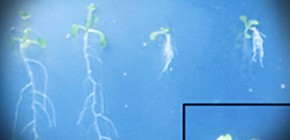
Clarification of mechanism involved in plant hormone transport
Under the leadership of TANAKA Hirokazu , Assistant Professor, KITAKURA Saeko , Researcher at the Graduate School of Science, Osaka University , and Dr. Jiri Friml at Ghent University , Belgium, a group of researchers clarified that a plant ( Arabidopsis thaliana ) used two endosomal components BEN1 and BEN2 in order to transport auxin, a plant hormone playing an important role in plant body development. This group has also demonstrated that this mechanism was used in controlling a variety of courses of development such as root formation and pattern formation of leaf veins. The discovery of this group is considered an important understanding regarding the regulation of directional auxin transport.
Abstract
PIN-FORMED (PIN) proteins localize asymmetrically at the plasma membrane and mediate intercellular polar transport of the plant hormone auxin that is crucial for a multitude of developmental processes in plants. PIN localization is under extensive control by environmental or developmental cues, but mechanisms regulating PIN localization are not fully understood. Here we show that early endosomal components ARF GEF BEN1 and newly identified Sec1/Munc18 family protein BEN2 are involved in distinct steps of early endosomal trafficking. BEN1 and BEN2 are collectively required for polar PIN localization, for their dynamic repolarization, and consequently for auxin activity gradient formation and auxin-related developmental processes including embryonic patterning, organogenesis, and vasculature venation patterning. These results show that early endosomal trafficking is crucial for cell polarity and auxin-dependent regulation of plant architecture.

Figure 1

Figure 2
To learn more about this research, please read the full research report entitled " Cell Polarity and Patterning by PIN Trafficking through Early Endosomal Compartments in Arabidopsis thaliana " at this page of the PLOS Genetics website.
Related link :

